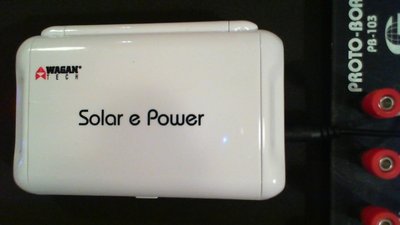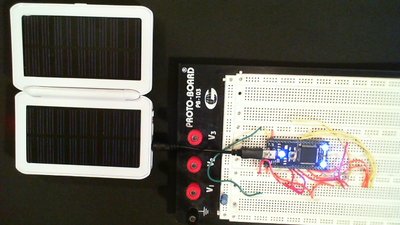Solar, Battery, Car, and AC power for mbed in one small module.
I got one of the Wagan Solar e Power II model 2558 solar cell charger modules in from Fry's and gave it a try. Overall the quality seems OK. Just a bit larger than an older cell phone or a billfold.

The mini USB cable provided with it fits mbed, or you can plug the larger mbed USB cable into it's two USB connectors on the side. Either way it just plugs in without mods. Flip the power switch and my mbed is running. The case opens up to expose two Solar cells - a bit more area than some of the lower cost ones. A small red LED lights up when the Solar cells are charging the battery.

Here it is above running the blink LED example code and you can see the relative size. So the specs say that the Solar cell output is 5.5V at 1.65W and it will generate 300MA of charge current from the Solar cell. Internal lithium batteries are 2000 mAH and the output with both USB connectors can be up to 1A. The output can be switched in three ranges from 4.5-9V. It comes with a car lighter plug and an AC adapter (90-240V) for charging without Solar. It also has an LED flashlight feature and adapters to charge most cell phones.
Overall not a bad way to go for a mobile mbed setup - as long as it does not need a lot of current for external devices. The students bought a really cheap Solar charger (a real no name brand) first and it turned out the Solar cells were not even connected on it! It was just a battery pack with an AC charger. Perhaps this one is a bit pricey, but everything seems to work, it's handy, and no mods are needed out of the box.
I am looking around for a nice easy to use setup for running student mbed projects off of solar power. I have seen a couple modules with a small solar panel and battery. I suspect there are probably some other options out there. I also need to tell students how to reduce power consumption (just a bit) at times and I have seen a couple forum posts about it, so I realize that you will not get to really low power levels. I need several, so I would like to avoid building things up, if possible.
So here are a couple of the small solar power modules with a charger and internal batteries in the $50 range that I found:
One for Arduino and other microcontrollers from http://www.nuelectronics.com, but they say out of stock. Are there other sources for it?
And this one from Wagan Tech to charge cell phone and USB devices with an internal battery is available from http://www.frys.com.
Has anyone seen some others I should look into - perhaps with a bit more power?